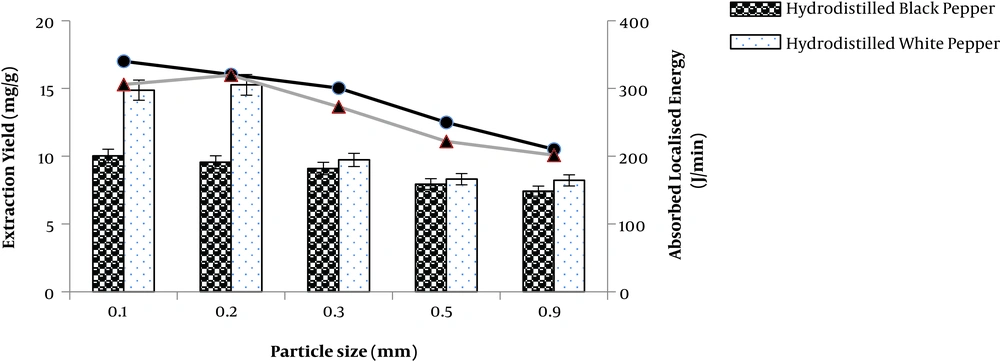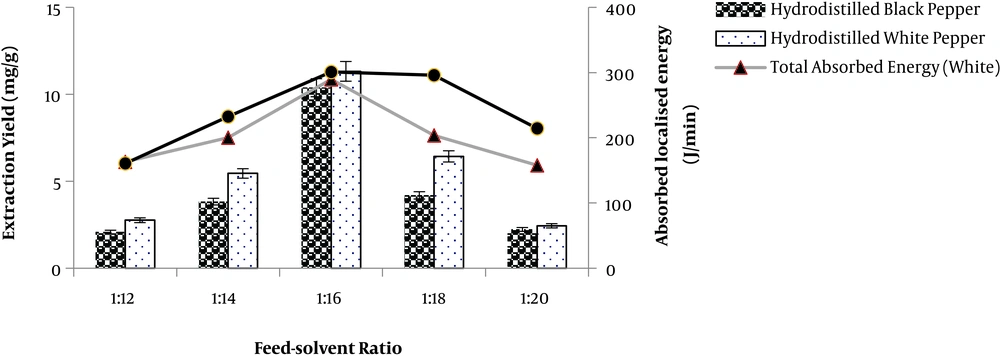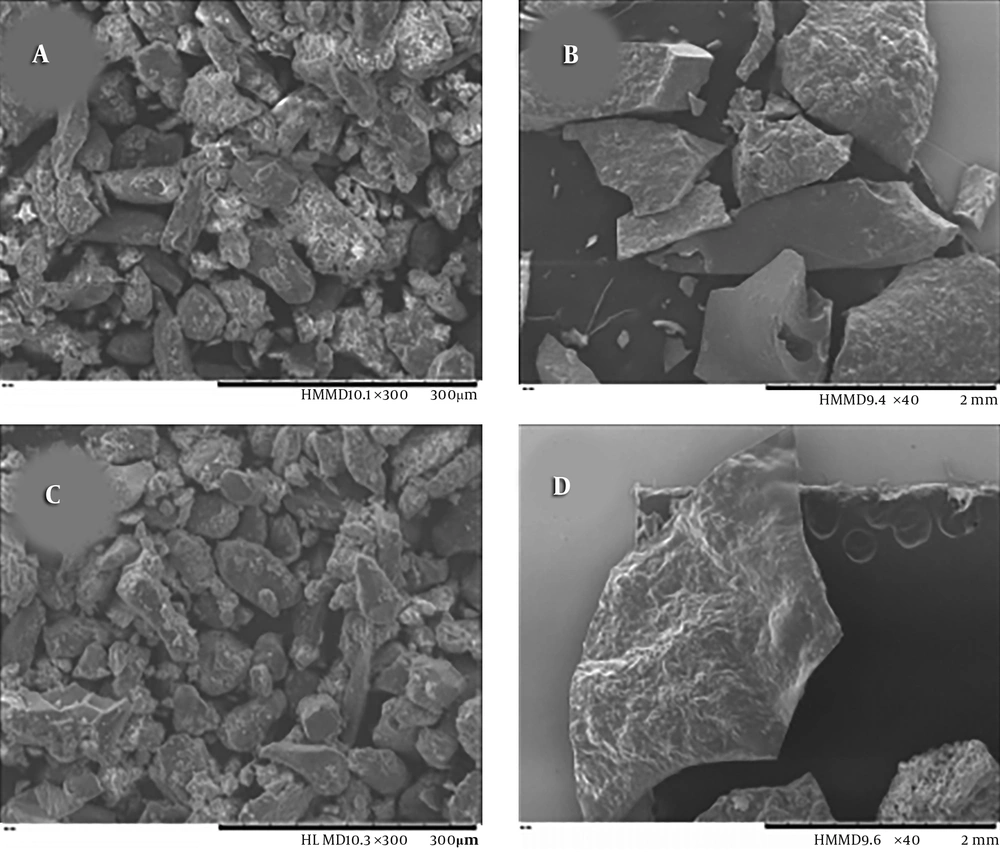1. Background
Black- and white peppers (Piper nigrum) are important functional food used as additives in food industries. The use of these commodity crops for nutritive purposes is due to their amazing aroma and pungency property (1). Fresh black and white peppers are flowering vines of Piperaceae family found mostly in tropical countries such as India, Malaysia, Brazil, and Thailand. While the white pepper is usually produced from fully matured peppercorns, the black pepper is made from the unripe green berry fruits. Recently, the oleoresin extracts (fixed oil) from black- and white pepper are used for treating the common cold, fever and many inflammatory diseases (2). The extracts also offer a remarkable alternative medicine for a lot of free radical-related disorders such as cancer, diabetes, cardiovascular, and some neurological diseases (3). Research has shown the effects of oleoresin extracts in the stimulation of gastrointestinal walls, which explains its medicinal activities in the prevention of constipation and indigestion (2). Meghwal (4) investigated the anti-inflammatory properties of black- and white pepper extracts and it was discovered to inhibit snake and scorpion poisons.
Heat reflux extraction is a conventional method used in the extraction of medicinal constituents from tough nuts, wood, seeds, and hard surface powdered natural products (5). The AOAC method is used for the extraction of essential oils and fixed oils from seeds (6). Silva et al. (6) reported three categories of hydrodistillation process, which consisted of the water immersion, vapor immersion, and direct vapor immersion. This is achieved by the use of a steam or reflux system. The former involves a mixture of distilled water and plant sample with the addition of heat in adequate proportions, while the latter involves passing steam through a bed of plant matrix (7). In both approaches, the hydrated plant sample is distilled and the extract turned into a vapor phase. The condensation of this vapor formed a water-extract phase layer, which can later be separated out to obtain pure extracts (7). The merit of this method is the use of a low-cost inorganic (water) solvent and simplicity of equipment set-up (7), which is implemented before the dehydration of the plant matrix and it is the most suitable when the pepper sample is in dried form (6). The simplicity and availability of its auxiliary equipment make it a better option compared to other extraction methods (5). The advantages of extracting non-volatile oil (i.e. fixed oil) instead of essential oil are that it presents a complete bioactive extract for a myriad of medicinal and nutritional applications.
2. Objectives
The aim of this study was to determine the influence of extraction parameters (extraction time, feed particle size, and solvent volume) on the extraction yield, antiradical properties, surface topology, and dietary elemental composition of black- and white pepper fixed oil.
3. Methods
3.1. Materials
Black- and white peppers (Piper nigrum) were purchased from Malaysia Pepper Board (MPB), Sarawak Malaysia. The pepper seed was air-dried for 3-days and later pulverized into powder using a Grindomix grinder (Knife-200 model, Germany). The powdered samples were then categorized into different particle sizes (0.105 mm, 0.154 mm, 0.300 mm, 0.450 mm and 0.900 mm) using the Retsch vibration shaker (AS 200 Basic-Model). The sieved samples were thereafter stored in sealed nylon. Analytical grade ethanol (99.9% purity), and distilled water were obtained from the Chemical Laboratory, University Malaysia Pahang, Kuantan. For antioxidant assay; 2,2-diphenyl-1-picrylhydrazyl reagent was purchased from Sigma Aldrich Chemical Co. These chemicals were used without subjecting them to further purification.
3.2. Heat Reflux Extraction and Analysis of Heat Energy Absorbed
Twenty-five grams of the samples were accurately weighed and loaded into a 1L volumetric flask containing distilled water, in accordance with the method used by Jiang et al. (8); but modified into a reflux configuration. The sample was then filtered and concentrated using the rotary evaporator. The extraction yield was calculated on dry weight basis and stored at 4°C and kept away from light. Because of heat loss, not all the energy released from a heat reflux system is converted into thermal energy (9). This energy was estimated from the amount of solvent used up during the extraction process (wf - wi) together with the temperature difference (Tf - Ti). The total absorbed energy (Qtotal) is, therefore, an accumulation of sensible heat (Qsensible) and the heat of vaporization (Qvap.) as presented in Equation 1.
where ρ is the density of water (g/cm3), V is the volume of water (cm3), Cp is the specific heat capacity of water (Jg-1°C-1), hfg is the latent heat of vaporization of water (Jg-1), t is the extraction time (min), Tf is final temperature (°C), Ti is the initial temperature (°C). Moreover, wi and wf are the initial and final weight of solvent before and after the extraction, respectively.
3.3. DPPH Antiradical Evaluation
Furthermore, DPPH radical scavenging activity was performed (10). In brief, 0.1 mM of 2, 2-diphenyl-1-picrylhydrazyl (DPPH) working solution was prepared by diluting 10 mL stock DPPH solution in 90 mL of analytical grade ethanol (99.95% purity). Then 2.5 mL of the DPPH working solution was added to 0.5 mL of different extract concentrations (A1). The negative control (blank) was prepared by adding 0.5 mL of ethanol with 2.5 mL of DPPH solution (A0). The A2 comprises of mixture 0.5mL of fixed oil extracts (at different concentration of 50 - 250 µg/mL) and 2.5 mL ethanol. Absorbance was measured after 30 min of incubation in the dark. The DPPH radical scavenging activity was calculated using Equation 2.
The antiradical power (ARP) was thereafter calculated by finding the inverse of IC50 value.
3.4. Scanning Electronic Microscopy and Energy Dispersive Analysis
A Hitachi tabletop scanning electron microscopy (SEM) (TM3030Plus, Japan) was used to examine the morphological changes in the sample before and after extraction. The SEM-images were used to determine the morphological changes from the conventional heat application layer gold before analyzing. Moreover, energy dispersive is an analytical method employed in the elemental characterization of organic and inorganic samples. It works on the fundamental principle of spectroscopy, which is assumed that each element in an atomic structure has its own unique fingerprints. Hence a characteristic set of peaks is generated on its electromagnetic emission spectra. To determine the dietary elements in the oleoresin extract, a 15 kV voltage and 40 - 300 magnification were used at a distance of 6 mm. In this study, the elemental compositions of fresh dried black- and white peppers were obtained through energy-dispersive X-ray (EDX) spectroscopy. The EDX of the oleoresin extract were conducted on a Hitachi TM 3030 Plus tabletop microscope. The samples were coated with a gold thin layer to decrease the electron charge on the sample surface and enhance sharpness. In addition, 30 s acquisition time and 5 s process time settings were used.
3.5. Brunauer-Emmett-Teller Analysis
The specific volume distribution and pore size transformation were examined using the results from Brunauer-Emmett-Teller (BET) analysis. The analysis was carried out using a micrometric unit (ASAP 2020, USA). The rate of structural deformation and surface area changes after the extraction process was carefully elucidated. The cumulative specific pore volume and pore diameters were estimated using 0.140 g of the samples, at a degassing temperature of 110°C in a slow mode for 3 h. The BET data were then analyzed using a computer-controlled physisorption analyzer.
3.6. Statistical Analysis
The results were analyzed using ANOVA test and all experimental procedures were conducted in triplicates. The standard deviation (± SD) between groups of value was estimated to express the extraction conditions using the largest donating rules.
4. Results and Discussion
4.1. Investigation of Parametric Effects
A single-factor experiment was used to investigate the effects of three extraction variables on the extraction yield and absorbed heat energy. The merit of this method is that it gives information about the periodic changes in each experimental run, rather than the overall design matrix (11). This design helps to determine the significance of each extraction variable on the response setting, as opposed to varying the factors simultaneously. The extraction parameters were comprised of the extraction time (x1), feed particle size (x2), and feed-solvent ratio (water volume) (x3).
4.1.1. Influence of Extraction Time
The extraction time was defined as 60, 120, 180, 240, and 300 min at a constant feed particle size (0.105 mm) and water volume (400 mL i.e. feed-solvent ratio 1:16). The experiments were conducted at the boiling temperature of water (100 °C). With an increasing extraction time from 30 min to 90 min, the oleoresin yield from black pepper was increased accordingly. Similarly, as the extraction time increased from 60 min to 240 min, the extraction yield of the oleoresin from white pepper was increased. However, the maximum yield was achieved at 240 and 180 min, when black- and white peppers were heat-refluxed, respectively. Under this condition, the optimum yield of 9.22 mg/g and 14.04 mg/g were attained for black pepper oleoresin (BPOE) and white pepper oleoresin (WPOE), respectively. The results revealed that the amount of extracted WPOE was higher than BPOE. This could be attributed to the differences in their maturation time. Similarly, the total energy absorbed by the sample peaked at the point where the extraction yield was the highest. These energies were higher in black pepper (220 J/min) than when white pepper (210 J/min) was heat-refluxed. This suggests that the energy required to extract spice oleoresin from black pepper is more than that required for white pepper. This is because the forces of attraction at the cellulosic cell wall of black pepper are believed to be higher than that of the white pepper (12). Figure 1 illustrates the effects of extraction time on the extraction yield and energy absorbed by the water-pepper matrix.
4.1.2. Influence of Particle Size
The feed particle sizes were defined as 0.105, 0.154, 0.300, 0.45, and 0.900 mm at a constant extraction time (240 min for black pepper and 180 min for white pepper), the solvent volume of 400 mL (feed-solvent ratio 1:16) and at the boiling temperature of water (100°C). The oleoresin yield was recorded to have a maximum value at 0.105 and 0.154 mm particle size when black- and white pepper was heat-refluxed, respectively. Under this condition, the BPOE and WPOE were 10.02 and 15.27 mg/g, respectively. At this threshold, the absorbed energy by the water-pepper system was 304 and 320 J/min for black- and white pepper, respectively. Ultimately, there was a steady decrease in the extraction yield as the particle size increased beyond this point. For this reason, a finely divided pepper sample presented a larger surface area for solvent penetration. This is because fine pepper size absorbs more energy than the coarse particle. Figure 2 illustrates the effect of particle size on the extraction yield and total absorbed energy by the water-pepper system.
4.1.3. Influence of the Feed-Solvent Ratio
The feed-solvent ratio was defined as 1:12, 1:14, 1:16, 1:18 and 1:20, at a constant extraction time (240 min for black pepper and 180 min for white pepper), feed particle sizes (0.105 mm for black pepper and 0.154 mm for white pepper) and at the boiling temperature of water (100°C) as illustrated in Figure 3.
As the volume of water was increased from 300 to 400 mL (i.e. 1:12 to 1:16), there was a corresponding increase in the extraction yield. Up to this point, the total energy absorbed and energy required for solvent vaporization were increased with regard to volume rise. Beyond this point, the total absorbed energy by the sample was decreased as the vaporization energy was increased. This indicated when the volume of water exceeded 400 mL (1:16), most of the emitted energy vaporized a large volume of water according to Desai et al. study (13).
4.1.4. Determination of Extraction Condition
The choice of best extraction conditions was based on the ‘largest donating rule’ as reported by Liang et al. (14). The rule states that as far as each investigated factor is concerned, the maximum value, which affects the response should be the selected value. The extracts obtained from the parametric study at optimum conditions (Table 1) were then employed for subsequent physicochemical analysis.
| Parameters | Symbol | Unit | Black Pepper Heat Refluxed | White Pepper Heat Refluxed |
|---|---|---|---|---|
| Extraction time | x1 | min | 240 | 180 |
| Particle size | x2 | mm | 0.105 | 0.154 |
| Solvent volume | x3 | mL | 400 | 400 |
| Extraction yielda | - | mg/g | 10.38 ± 0.02 | 15.27 ± 0.05 |
Summary of the Selected Extraction Condition
4.2. Determination of Antiradical Power
The IC50 values were estimated to be 125.24 ± 0.20 µg/mL and 110.54 ± 0.01 µg/mL for BPOE and WPOE, respectively. A lower IC50 for the white pepper extract is an indication that the WPOE exhibited higher antioxidant activities than BPOE. Similarly, the ARP of the black- and white pepper extracts were estimated to be 0.007985 ± 0.23 and 0.009046 ± 0.15 mL/µg, respectively. From the ARP value, the WPOE was higher in antioxidant properties with 11.72% compared to BPOE. The higher ARP further confirmed the higher radical scavenging activity of WPOE, which is consistent with the result obtained by Liang-Liang and Jian-Guo (15).
4.3. Determination of Morphological Characteristics
The cellulosic cell wall of the fresh black- and white pepper fruits consist of neatly packed stone-like elongated parenchymatous cells as shown in Figure 4A and B. The application of localized heat in the pepper matrix results in the disorientation of the parenchymatous cells. Therefore the oil and water content inside the cellulosic structure coalesce, resulting in a pressure gradient and a subsequent rupture in the cell wall as shown in Figure 4C and D. The rupture of the cell wall leads to an accelerated mass transfer of volatile compound as reported by Olalere et al. (16).
4.4. Elemental Composition
Overall, ten dietary elements were identified from the elemental analysis conducted on the BPOE and WPOE viz carbon (C), oxygen (O), magnesium (Mg), aluminum (Al), silicon (Si), phosphorous (P), calcium (Ca), potassium (K), nitrogen (N) and sulphur (S). Among the dietary elements in the extract, C and O have the highest concentration, while Mg, Al, Si, Ca, and K are in moderate amount. However, P, N, and S are in trace amounts. Their presence in trace amounts has led to neglecting their significant role in combating many nutritive and degenerative disorders. The variation in the elemental concentration in both BPOE and WPOE can be attributed to the differences in their chemical structure occasioned by their maturation time (5). The dietary elements such as Mg, Ca, Si, and K are classified as essential dietary elements, while N and S are nearly non-essential to the human body. Potassium helps in the synthesis of nucleoproteins, metalloproteinase, chromoproteins, and lipoproteins, which aid the contraction of muscles, especially the cardiac muscles. Calcium aids the development of bone, rapid clotting of blood, regulation of heartbeat, and blood pressure. Magnesium reduces cholesterol level and helps in the conversion of excess blood glucose to useful energy. Silicon is another dietary element, which helps in the prevention of hardening the veins and arteries. These dietary elements can be explored in curative and preventive traditional medicine.
4.5. Determination of Textural Characteristics
The cumulative pore volume was plotted against the pore size in order to investigate the effects of localized heating on the microstructure of black- and white pepper. The results from the pore distribution curves revealed that the untreated sample exhibits higher pore volume and sizes prior to extraction. A careful comparison of both samples before and after the exposure to localized heating gave a percentage deformation as 43.56% in black pepper and 59.62% in white pepper in relation to their specific pore volume. Similarly, the structural deformation percent related to the black- and white pepper was estimated to be 21.47% and 29.14% in relation to changes in their pore sizes, respectively. This indicated that the deformation percentage is higher in white pepper than in black pepper, which could be due to differences in their maturation time.
5. Conclusions
This study shows the effects of extraction parameters on the fixed oil yield and the influence of heat energy on the antioxidant and structural integrity of black- and white pepper sample during heat reflux extraction. The result obtained from the ARP values indicated that white pepper exhibits higher antioxidant capacity than the black pepper while that SEM and BET results clearly revealed that the localized heating had a greater deformation effect on white pepper than black pepper.




